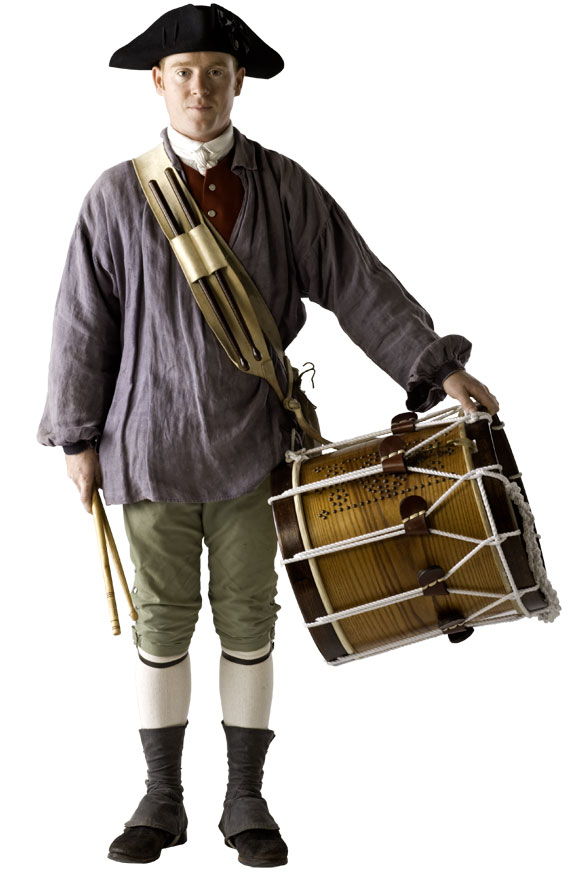Page content
The Second Virginia Regiment Uniform
Roll over image to view descriptions of the uniform worn by the Second Virginia Regiment.
See glossary of terms.

- Hat
- Tri-cornered hats are cocked at a military angle, centered over the left eye.
- Cockade
- An ornamental cockade is worn on the left. Today’s Fifes and Drums wear an all-black cockade, but styles and usage varied throughout the war.
- Cravat
- This cloth neck wrap is less formal than the stiff leather stock worn with a dress uniform.
- Buttons
- Eighteenth-century buttons would have been pewter, but that metal’s soft quality makes buttons too easily marred for use in Colonial Williamsburg’s Fifes and Drums, who now use a harder white metal.
- Shoulder belt
- The snare drummer’s instrument hangs from a buff leather strap slung from right shoulder to left hip, where the drum is attached with a hook. Spare drumsticks are stowed in special slots across the chest.
- Canteen
- One-quart canteens were issued to each soldier. A sling strap held the vessel ready at the left hip. Most canteens were small wooden casks, but some were made of tin or glass.
- Waistcoat
- A single-breasted waistcoat would have been made of linen broadcloth and fastened with 12 buttons. Waistcoat and breeches are known as small clothes. White was preferred, but civilian small clothes were dyed in many colors.
- Rifle shirt
- George Washington prized this rugged pullover for its four-season practicality. Based on a farmer’s smock, the garment allowed for ease of movement for both musician and rifleman. Frocks were dyed many colors; purple is a color specific to Williamsburg.
- Snare drum
- These wooden drums are slightly larger than the modern snare drum. Tension on calfskin heads is adjusted by tightening ropes laced through hoops at either end of the instrument. Gut snares strung across the lower hoop provide the drum’s signature rattling sound.
- Drumsticks
- Hardwood drumsticks are paired by weight and tone, and embellished with line designs.
- Breeches
- Linen or wool breeches are fitted across the front and roomy in the seat. Waistcoat and breeches are known as small clothes. White was preferred, but civilian small clothes were dyed in many colors.
- Garters
- Garters were traditionally worn by officers, and not the enlisted ranks. Colonial Williamsburg’s modern-day corps is issued garters for the expedient of securing stockings on young corps members' calves.
- Stockings
- White knitted stockings of wool, linen, or cotton protected the lower leg.
- Spatterdashes
- A practical alternative to more expensive boots, spatterdashes of linen canvas or wool protected the calf and kept legs warm.
- Shoes
- Black leather shoes fastened with polished brass buckles are worn by every member of today’s Fifes and Drums.
